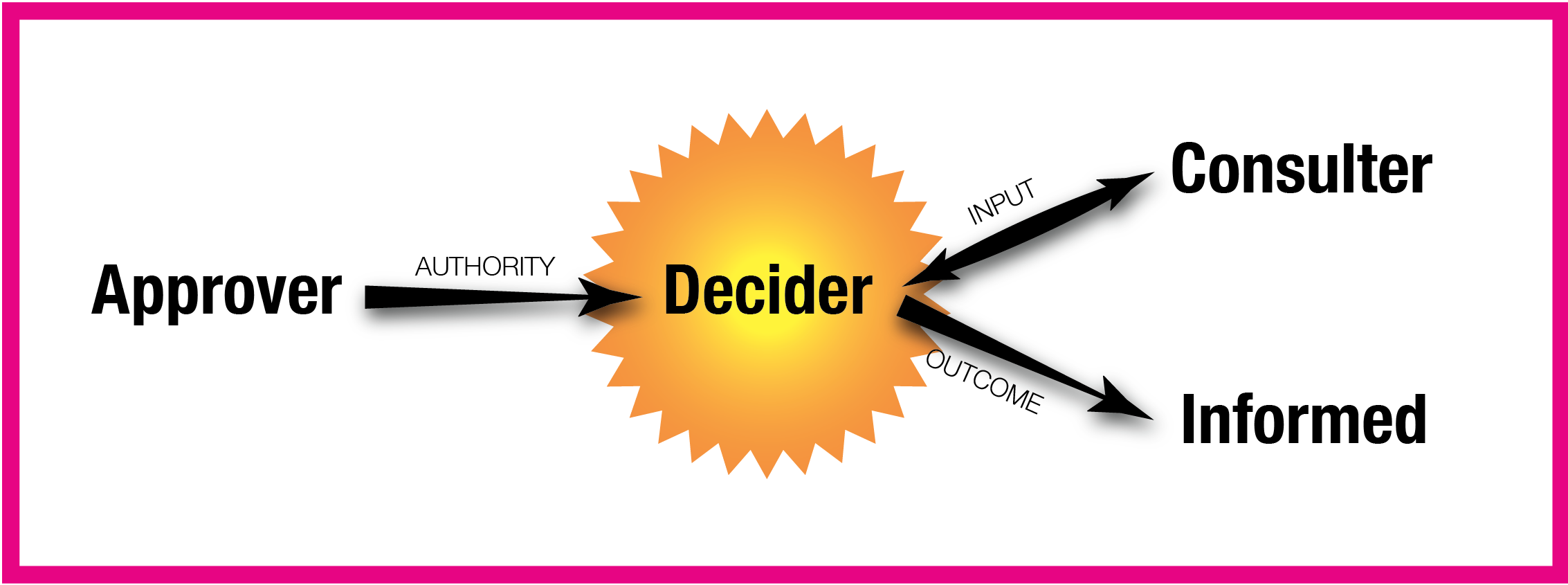Four key roles support a good decision-making process, and should be patterned into your organization.
Speaking (extremely) generally, in my work with independent schools and colleges, some employees (mostly faculty) often ask for more influence on decision-making, while others (mostly staff) often express a desire to be better informed of decisions that affect them. In some ways, these two groups represent the poles of “participatory decision-making” and “organizational efficiency” respectively. Similarly disparate frustrations of “I didn’t agree to this” vs “just tell me what to do” align along the same spectrum. This pattern exists at other types of organizations as well.
Transcending this dichotomy is a common desire for clarity: Who makes or influences decisions? What makes those decisions legitimate? What are the standard methods for the communication of decisions once made?
The fact that these questions are common to both sides of “the faculty/staff divide” implies that in answering these questions, schools can gain significant advantage.
In my previous post, I covered Decision-Types, which is a critical consideration in good decision-making process. In today’s post, I want to cover Decision Roles.
Decision Making Roles: ADCI
Decision-makers in organizations are often easy to identify, but in organizations where decision-making is consistently of a high quality, a constellation of supporting roles add critical value. The four key roles in decision-making at schools include:
Approving Role (Approver)
Parties serving in the Approving Role grant authority to a Decider. Approvers may demand explicit approval of types of decisions (e.g. heavyweight decisions) but grant implicit approval for others. Most importantly, there can only be one Approver per decision. [1]
Deciding Role (Decider)
The Decider makes decisions, choosing a method of decision-making (e.g. dice roll, formula, vote, executive action) as well the final result. Like Approvers, there should be just one Decider. Every Decider has an Approver: even the President of the United States requires approval from co-equal branches of government (which then take their approval from the people.) A Decider cannot serve as “self approver,” but their actions may benefit from implicit approval (see below).
Consulting Role (Consulters)
Consulters are involved in two-way communication about decisions. There is no limit on Consulters—except practicality. Consulters may individuals, groups, information systems, or documentary sources. Any party expected to implement a decision should be included as a Consulter in the decision-making process. Care should be taken to ensure that Consulters understand that they serve as a source of information, guidance, or even recommendation—but not approval or decision.
Informed Role (Informed)
Some parties don’t have input, but should be Informed after a decision has been made. This is one-way communication. Parties to be informed should be defined in advance of the decision-making process.
Why Are These Roles Necessary?
Various organizational maladies can be traced to a lack of clarity around these roles. After-the-fact objections to decisions—outcomes or process—often indicates insufficient Consultation. Confusion in implementation indicates that more Informing is required. Micromanagement, scapegoating, or whipsawing, implies a challenge around the Decider/Approver interface.
While good role definition is hallmark of productive organizations of all types, there are some school-specific implications of decision-roles that are worth considering:
Parents and Alumni. Third parties such as alumni or parents may often be Informed or Consulted, but rarely serve in Deciding or Approving roles except as part of a formal committee or task force with an appropriate charter or bylaws.
Handbooks Matter. Some Approvers may demand explicit approval of many decisions … but others may grant implicit, standing approval to the Decider with only occasional review and oversight. In some cases, documentation like a Student or Faculty Handbook may provide parameters within which a Decider can operate with implicit approval.
Reporting Can Be Strange at Schools. At schools, particularly boarding schools, relationships between Approvers and Deciders can vary depending on the duties, skillsets, and the reporting relationship. Every employee has a person to whom they formally “report” in the org chart, and that person is their Functional Manager—but they might also have a Program Manager who is in charge of the event, activity, or role they are filling at the time. Even a Principal or Head of School might “report” to a program manager if they are filling roles like coach, teacher, or chaperone.
Try it, Out Loud
If you think about it, most organizations conduct decision-making in a remarkably unstructured and improvisational way, relying on management “style” to govern what is one of the most important systems in the organization. Give these roles a try. Coupled with clarity over decision-type, these structures can bring a powerful, systems approach to decision-making.
When first adopting these approaches, I encourage you to be be vocal, deliberate, and demonstrative in assessing decision-type and assigning appropriate decision roles. Sooner or later, the process will become habit, and high-quality decision-making will become an everyday norm at your institution. A diagram of the relationship between decision-making roles.

[1] A group can serve as an Approver or Decider if they act as one through clear methods. For example, the Board of Trustees operates as a single Approver or Decider through clear, documented voting process based on Robert’s Rules of Order.